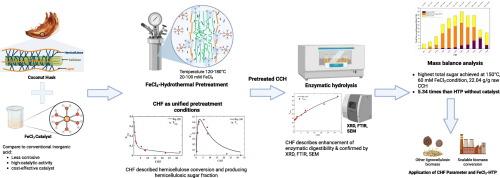Prediction by a modified severity factor in FeCl₃-catalyzed hydrothermal fractionation of coconut husk: Enhancing hemicellulose hydrolysis and enzymatic digestibility of cellulose
Q1 Environmental Science
引用次数: 0
Abstract
Hydrothermal pretreatment (HTP) is essential for producing valuable hemicellulosic sugars and enhancing the enzymatic digestibility of lignocellulosic biomass for biofuel and biochemical production. However, conventional methods are often limited by high energy demands and low sugar yields. This study explores the catalytic role of ferric chloride (FeCl₃) as a less corrosive, high-catalytic activity, and cost-effective alternative to inorganic acids in the HTP of coconut husk (CCH), with the goal of improving hemicellulose hydrolysis and subsequent enzymatic conversion. The pretreatment was carried out at 120–180 °C with FeCl₃ concentrations ranging from 20 to 100 mM. A mathematically derived Combined Hydrolysis Factor (CHF) was applied to unify pretreatment conditions and correlate them with xylan hydrolysis, hemicellulosic sugar yield, compositional changes in CCH, and improvements in enzymatic digestibility. The results showed that FeCl₃-HTP enabled substantial to near-complete hemicellulose removal, exhibited a strong correlation between xylan removal and xylose release, and significantly enhanced enzymatic digestibility, as confirmed by XRD, SEM, and FTIR analyses. Mass balance analysis identified the optimal condition at 150 °C and 60 mM FeCl₃, yielding 22.04 g of total sugar per 100 g of raw CCH, 5.34 times higher than the yield from non-catalyzed pretreatment at the same temperature. These findings confirm the effectiveness of FeCl₃ as catalytic agent and establish CHF as a reliable predictive parameter for optimizing sugar recovery in scalable biomass conversion processes, highlighting its potential applicability to other lignocellulosic biomass as transferrable parameter under similar catalytic system, such as oil palm empty fruit bunches, for high-value bioproduct production.

用改进的严酷因子预测FeCl₃催化椰壳水热分馏过程:提高半纤维素水解和纤维素酶消化率
水热预处理(HTP)对于生产有价值的半纤维素糖和提高用于生物燃料和生化生产的木质纤维素生物质的酶消化率至关重要。然而,传统的方法往往受到高能量需求和低糖产量的限制。本研究探讨了三氯化铁(FeCl₃)作为一种腐蚀性小、催化活性高、成本效益高的无机酸在椰子壳(CCH) HTP中的催化作用,目的是改善半纤维素水解和随后的酶转化。预处理温度为120 ~ 180℃,FeCl₃浓度为20 ~ 100 mM。采用数学推导的复合水解因子(CHF)来统一预处理条件,并将预处理条件与木聚糖水解、半纤维素糖产量、CCH组成变化和酶消化率的提高相关联。结果表明,通过XRD、SEM和FTIR分析,FeCl₃-HTP能够几乎完全去除半纤维素,在木聚糖去除和木糖释放之间表现出很强的相关性,并且显著提高酶消化率。质量平衡分析表明,在150°C、60 mM FeCl₃的条件下,每100 g原料CCH的产糖率为22.04 g,比相同温度下非催化预处理的产糖率高5.34倍。这些发现证实了FeCl₃作为催化剂的有效性,并建立了CHF作为可扩展生物质转化过程中优化糖回收的可靠预测参数,突出了其在类似催化体系下作为其他木质纤维素生物质可转移参数的潜在适用性,例如油棕空果束,用于高价值生物产品的生产。
本文章由计算机程序翻译,如有差异,请以英文原文为准。
求助全文
约1分钟内获得全文
求助全文
来源期刊

Bioresource Technology Reports
Environmental Science-Environmental Engineering
CiteScore
7.20
自引率
0.00%
发文量
390
审稿时长
28 days
 求助内容:
求助内容: 应助结果提醒方式:
应助结果提醒方式:


